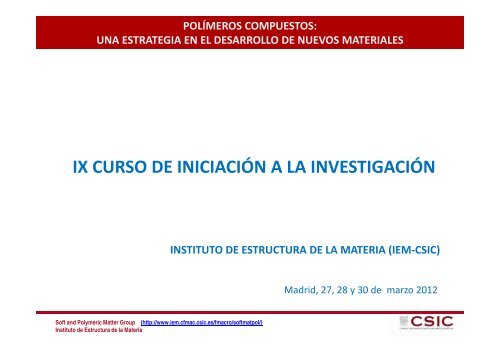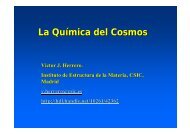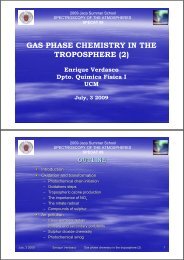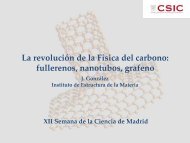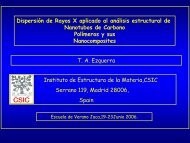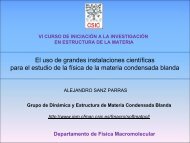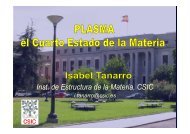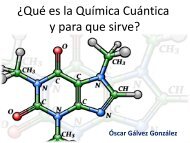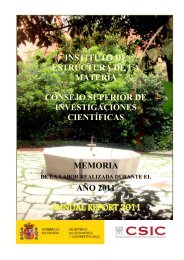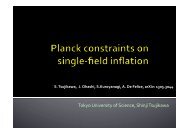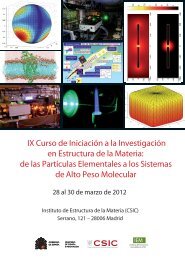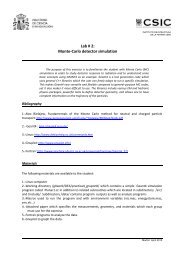PolÃmeros compuestos - Instituto de Estructura de la Materia
PolÃmeros compuestos - Instituto de Estructura de la Materia
PolÃmeros compuestos - Instituto de Estructura de la Materia
- No tags were found...
You also want an ePaper? Increase the reach of your titles
YUMPU automatically turns print PDFs into web optimized ePapers that Google loves.
POLÍMEROS COMPUESTOS:UNA ESTRATEGIA EN EL DESARROLLO DE NUEVOS MATERIALESMATRICES• Metálicas : aluminio, magnesio, cobre, níquel y aleaciones. Aplicaciones aeroespaciales yautomotrices. Permite que el compuesto funcione a altas temperaturas pero <strong>la</strong> producción<strong>de</strong> una pieza <strong>de</strong> este tipo es costosa.• Cerámicas: incluyen sólidos inorgánicos no metálicos (silicatos, alúmina, carburo <strong>de</strong>silicio). Buenas propieda<strong>de</strong>s a temperaturas muy elevadas, ligeros y frágiles.• Poliméricas: termoestables, termoplásticos y e<strong>la</strong>stómeros. Buenas propieda<strong>de</strong>smecánicas, resistentes a <strong>la</strong> corrosión y a los agentes químicos. Pue<strong>de</strong>n ser mol<strong>de</strong>ados conamplia variedad <strong>de</strong> formas.Soft and Polymeric Matter Group (http://www.iem.cfmac.csic.es/fmacro/softmatpol/)<strong>Instituto</strong> <strong>de</strong> <strong>Estructura</strong> <strong>de</strong> <strong>la</strong> <strong>Materia</strong>
POLÍMEROS COMPUESTOS:UNA ESTRATEGIA EN EL DESARROLLO DE NUEVOS MATERIALESFibrasPartícu<strong>la</strong>s<strong>Estructura</strong>lescontinuo y alineadoDiferentes tamañosdistribuidos al azardiscontinuo y alineado<strong>la</strong>minardiscontinuo y distribuido al azartipo sandwichtipo sandwichSoft and Polymeric Matter Group (http://www.iem.cfmac.csic.es/fmacro/softmatpol/)<strong>Instituto</strong> <strong>de</strong> <strong>Estructura</strong> <strong>de</strong> <strong>la</strong> <strong>Materia</strong>
POLÍMEROS COMPUESTOS:UNA ESTRATEGIA EN EL DESARROLLO DE NUEVOS MATERIALESFASE CONTINUAP c = ∑ f i p iFASE DISCONTINUAINTERFASEPOSIBILIDAD DE DISEÑAR Y FABRICAR UN MATERIAL SEGÚNESPECIFICACIONES CONCRETASSoft and Polymeric Matter Group (http://www.iem.cfmac.csic.es/fmacro/softmatpol/)<strong>Instituto</strong> <strong>de</strong> <strong>Estructura</strong> <strong>de</strong> <strong>la</strong> <strong>Materia</strong>
POLÍMEROS COMPUESTOS:UNA ESTRATEGIA EN EL DESARROLLO DE NUEVOS MATERIALES LGfibramatriz SLaire SGW a = SG + LG ‐ SL•Si = 180º <strong>la</strong> gota es esférica con un únicopunto <strong>de</strong> contacto entre el líquido y el sólido. Eneste caso NO se produce <strong>la</strong> impregnación.•Si =0º se produce una impregnaciónperfecta.•En general, se consi<strong>de</strong>ra que el líquido noimpregna al sólido si el ángulo <strong>de</strong> contacto esmayor <strong>de</strong> 90º.Soft and Polymeric Matter Group (http://www.iem.cfmac.csic.es/fmacro/softmatpol/)<strong>Instituto</strong> <strong>de</strong> <strong>Estructura</strong> <strong>de</strong> <strong>la</strong> <strong>Materia</strong>
POLÍMEROS COMPUESTOS:UNA ESTRATEGIA EN EL DESARROLLO DE NUEVOS MATERIALESa) Unión mecánica. La existencia <strong>de</strong> rugosida<strong>de</strong>s entre ambas superficies favorecen <strong>la</strong>unión, en el sentido <strong>de</strong> que a mayor rugosidad más efectiva es <strong>la</strong> unión en <strong>la</strong> interfase.b) Unión electrostática. Este tipo <strong>de</strong> unión se da cuando una <strong>de</strong> <strong>la</strong>s superficies tienecarga positiva y <strong>la</strong> otra negativa.c) Unión química. Cuando <strong>la</strong> superficie <strong>de</strong> <strong>la</strong> fase discontinua tiene grupos químicoscompatibles con grupos químicos <strong>de</strong> <strong>la</strong> fase continua.d) Unión mediante difusión. Ambas fases tienen ca<strong>de</strong>nas poliméricas que se difun<strong>de</strong>nentre el<strong>la</strong>s.Soft and Polymeric Matter Group (http://www.iem.cfmac.csic.es/fmacro/softmatpol/)<strong>Instituto</strong> <strong>de</strong> <strong>Estructura</strong> <strong>de</strong> <strong>la</strong> <strong>Materia</strong>
POLÍMEROS COMPUESTOS:UNA ESTRATEGIA EN EL DESARROLLO DE NUEVOS MATERIALESPP+ sepiolita tratada con al<strong>de</strong>hido enánticoPP+ sepiolita tratada con al<strong>de</strong>hido <strong>de</strong>cílicoSoft and Polymeric Matter Group (http://www.iem.cfmac.csic.es/fmacro/softmatpol/)<strong>Instituto</strong> <strong>de</strong> <strong>Estructura</strong> <strong>de</strong> <strong>la</strong> <strong>Materia</strong>
POLÍMEROS COMPUESTOS:UNA ESTRATEGIA EN EL DESARROLLO DE NUEVOS MATERIALES¿Qué es un polímero?La pa<strong>la</strong>bra polímero proce<strong>de</strong> <strong>de</strong>l griego: poly (muchos) y meros (parte)Los polímeros se producen por <strong>la</strong> unión <strong>de</strong> cientos <strong>de</strong> miles <strong>de</strong> molécu<strong>la</strong>s pequeñas<strong>de</strong>nominadas monómeros (grupos funcionales) que forman enormes ca<strong>de</strong>nas <strong>de</strong> <strong>la</strong>sformas más diversasLa mayor parte <strong>de</strong> los polímeros están formados por estructuras <strong>de</strong> carbón y por tanto seconsi<strong>de</strong>ran <strong>compuestos</strong> orgánicosAunque existen polímeros naturales (algodón, celulosa, seda, <strong>la</strong>na) <strong>de</strong> gran valorcomercial, <strong>la</strong> mayor parte <strong>de</strong> los polímeros que usamos en nuestra vida diaria, sonmateriales sintéticos con propieda<strong>de</strong>s y aplicaciones variadasSoft and Polymeric Matter Group (http://www.iem.cfmac.csic.es/fmacro/softmatpol/)<strong>Instituto</strong> <strong>de</strong> <strong>Estructura</strong> <strong>de</strong> <strong>la</strong> <strong>Materia</strong>
POLÍMEROS COMPUESTOS:UNA ESTRATEGIA EN EL DESARROLLO DE NUEVOS MATERIALESsegún su composición:n homopolímerocopolímero al azarcopolímero en bloquecopolímero <strong>de</strong> injertoSoft and Polymeric Matter Group (http://www.iem.cfmac.csic.es/fmacro/softmatpol/)<strong>Instituto</strong> <strong>de</strong> <strong>Estructura</strong> <strong>de</strong> <strong>la</strong> <strong>Materia</strong>
según su estructura:POLÍMEROS COMPUESTOS:UNA ESTRATEGIA EN EL DESARROLLO DE NUEVOS MATERIALESlineal ramificado entrecruzadosegún su comportamiento frente a <strong>la</strong> temperatura:Termoplásticos: <strong>de</strong>spués <strong>de</strong> ab<strong>la</strong>ndarse o fundirse, recuperan sus cualida<strong>de</strong>s originales alenfriarse. En general son polímeros lineales, con bajas T m y solubles en disolventesorgánicos. Se pue<strong>de</strong>n mol<strong>de</strong>ar repetidamente.Termoestables: sufren una serie <strong>de</strong> reacciones químicas, l<strong>la</strong>madas <strong>de</strong> curado o reticu<strong>la</strong>ción,dando lugar a un producto rígido, insoluble e infusible. Se <strong>de</strong>scomponen a altastemperaturas. No se pue<strong>de</strong>n volver a mol<strong>de</strong>ar.Soft and Polymeric Matter Group (http://www.iem.cfmac.csic.es/fmacro/softmatpol/)<strong>Instituto</strong> <strong>de</strong> <strong>Estructura</strong> <strong>de</strong> <strong>la</strong> <strong>Materia</strong>
POLÍMEROS COMPUESTOS:UNA ESTRATEGIA EN EL DESARROLLO DE NUEVOS MATERIALESPOLÍMEROSTERMOESTABLESResinas epoxiepliclorhidrinabisfenol AepliclorhidrinaOCH 2 CH CH 2 OCH 3COCH 2CHOCH 2CH 3H 2 N –CH 2 ‐ (CH 2 ) n –CH 2 –NH 2OCH 2 CH CH 2 OCH 3COCH 2CHOCH 2CH 3Soft and Polymeric Matter Group (http://www.iem.cfmac.csic.es/fmacro/softmatpol/)<strong>Instituto</strong> <strong>de</strong> <strong>Estructura</strong> <strong>de</strong> <strong>la</strong> <strong>Materia</strong>
POLÍMEROS COMPUESTOS:UNA ESTRATEGIA EN EL DESARROLLO DE NUEVOS MATERIALESPoliésteres insaturadosR' ‐ n (HC = CH – COO) n –R'CH=CH 2estirenoR' ‐ n (HC = CH – COO) n –R'PolicarbonatoH 2 C = CH –CH 2 OH alcohol alílicoHO –CH 2 –CH 2 –OH etilen glicolCH 2 = CH –CH 2 –O –CO –O‐ CH 2 –CH 2 –O –CO –CH 2 –CH = CH 2monómeroSoft and Polymeric Matter Group (http://www.iem.cfmac.csic.es/fmacro/softmatpol/)<strong>Instituto</strong> <strong>de</strong> <strong>Estructura</strong> <strong>de</strong> <strong>la</strong> <strong>Materia</strong>
POLÍMEROS COMPUESTOS:UNA ESTRATEGIA EN EL DESARROLLO DE NUEVOS MATERIALESTERMOPLÁSTICOSPolipropileno‐ CH 2 –CH –CH 3• es el termoplástico más utilizado como matriz• baja <strong>de</strong>nsidad• recic<strong>la</strong>bilidad• buenas propieda<strong>de</strong>s mecánicas y térmicasPolietilen terefta<strong>la</strong>to• gran transparencia• buena resistencia al fuego• buenas características eléctricas• resistencia a <strong>la</strong> fluenciaSoft and Polymeric Matter Group (http://www.iem.cfmac.csic.es/fmacro/softmatpol/)<strong>Instituto</strong> <strong>de</strong> <strong>Estructura</strong> <strong>de</strong> <strong>la</strong> <strong>Materia</strong>
POLÍMEROS COMPUESTOS:UNA ESTRATEGIA EN EL DESARROLLO DE NUEVOS MATERIALESPolicarbonato• gran transparencia• estabilidad dimensional y resistencia al fuego• poca resistencia a los disolventesTermoplásticos <strong>de</strong> altas prestaciones• estructura altamente aromática• alta resistencia mecánica y térmica• se emplea en <strong>la</strong> industria aeroespacial• coste elevado• dificultad <strong>de</strong> procesadopolisulfuro <strong>de</strong> fenilenoSoft and Polymeric Matter Group (http://www.iem.cfmac.csic.es/fmacro/softmatpol/)<strong>Instituto</strong> <strong>de</strong> <strong>Estructura</strong> <strong>de</strong> <strong>la</strong> <strong>Materia</strong>
POLÍMEROS COMPUESTOS:UNA ESTRATEGIA EN EL DESARROLLO DE NUEVOS MATERIALESPARTÍCULAS: L/D ≈ 1FASE DISPERSANegro <strong>de</strong> carbono• es un material producido por <strong>la</strong> combustión incompleta <strong>de</strong> los productos <strong>de</strong>rivados<strong>de</strong>l petróleo• es una forma <strong>de</strong> carbono amorfo con una re<strong>la</strong>ción superficie‐volumenextremadamente altas• se usa a menudo como pigmento y como refuerzo en productos <strong>de</strong> goma y plásticoArcil<strong>la</strong>s• sepiolita silicato <strong>de</strong> magnesio hidratadoMg 4 Si 6 O 15 (OH) 2 ∙6H 2 O• atapulgita hidroxisilicato <strong>de</strong> magnesio y aluminio(MgAl) 2 Si 4 O 10 (OH)∙4(H 2 O)• caolín disilicato alumínico dihidratadoAl 2 Si 2 O 5 (OH) 4 H 2 O• montmorillonita hidroxisilicato <strong>de</strong> magnesio y aluminio :(Na,Ca) 0,3 (Al,Mg) 2 Si 4 O 10 (OH) 2 ∙nH 2 OSoft and Polymeric Matter Group (http://www.iem.cfmac.csic.es/fmacro/softmatpol/)<strong>Instituto</strong> <strong>de</strong> <strong>Estructura</strong> <strong>de</strong> <strong>la</strong> <strong>Materia</strong>
POLÍMEROS COMPUESTOS:UNA ESTRATEGIA EN EL DESARROLLO DE NUEVOS MATERIALESFIBRAS: L/D >100Fibra <strong>de</strong> vidrio• se obtienen al hacer pasar vidrio fundido a través <strong>de</strong> una pieza <strong>de</strong> agujeros muy finos .Al solidificarse tienen suficiente flexibilidad paras esr usados como fibras• reducido precio y gran versatilidad, flexibles, buen ais<strong>la</strong>miento térmico, inerte a losácidos, estable a altas temperatura• se pue<strong>de</strong>n c<strong>la</strong>sificar según el tipo <strong>de</strong> vidrio (A, D, E) y según <strong>la</strong> disposición espacial:Hilo continuo fibra cortamat tejido hilosSoft and Polymeric Matter Group (http://www.iem.cfmac.csic.es/fmacro/softmatpol/)<strong>Instituto</strong> <strong>de</strong> <strong>Estructura</strong> <strong>de</strong> <strong>la</strong> <strong>Materia</strong>
POLÍMEROS COMPUESTOS:UNA ESTRATEGIA EN EL DESARROLLO DE NUEVOS MATERIALESFibras <strong>de</strong> carbono• ligeras, <strong>de</strong> gran resistencia y elevado modulo <strong>de</strong> e<strong>la</strong>sticidad aplicaciones aeroespaciales• elevado precio limita su uso en algunas industrias (como <strong>la</strong> automotriz)• baja <strong>de</strong>nsidad en comparación con el acero• provienen principalmente <strong>de</strong> dos fuentes, poliacrilonitrilo (PAN) y alquitrán• gran capacidad <strong>de</strong> ais<strong>la</strong>miento térmicofibras cortastejidoSoft and Polymeric Matter Group (http://www.iem.cfmac.csic.es/fmacro/softmatpol/)<strong>Instituto</strong> <strong>de</strong> <strong>Estructura</strong> <strong>de</strong> <strong>la</strong> <strong>Materia</strong>
POLÍMEROS COMPUESTOS:UNA ESTRATEGIA EN EL DESARROLLO DE NUEVOS MATERIALESFibras <strong>de</strong> aramida• se obtienen a partir <strong>de</strong> una poliamida aromática• <strong>la</strong> más utilizada es <strong>la</strong> Kev<strong>la</strong>r, sintetizada por Stephanie Kwolek en 1965 para Du Pont.• muy rígidas• baja <strong>de</strong>nsidad• excelente resistencia al impacto, al calor y a los disolvente• resistente a <strong>la</strong> corrosiónSoft and Polymeric Matter Group (http://www.iem.cfmac.csic.es/fmacro/softmatpol/)<strong>Instituto</strong> <strong>de</strong> <strong>Estructura</strong> <strong>de</strong> <strong>la</strong> <strong>Materia</strong>
POLÍMEROS COMPUESTOS:UNA ESTRATEGIA EN EL DESARROLLO DE NUEVOS MATERIALESFASE CONTINUA:Polietileno <strong>de</strong> alta <strong>de</strong>nsidad (HDPE)Poliamida 12Poliamida 6,6Y nosostros ……… ¿qué hacemos?Investigación <strong>de</strong> <strong>la</strong> conductividad eléctrica en materiales<strong>compuestos</strong> poliméricos con nanofibras <strong>de</strong> carbonoóptimamente dispersadasFASE DISCONTINUA:Nanofibras <strong>de</strong> carbono obtenidas por <strong>la</strong>técnica <strong>de</strong>l catalizador flotante losprecursores <strong>de</strong>l catalizador se introducen<strong>de</strong> forma continua por <strong>la</strong> parte superior<strong>de</strong>l reactor. El catalizador se forma a o<strong>la</strong>rgo <strong>de</strong>l <strong>de</strong>scenso por el reactor yreacciona con los hidrocarburos presentes(benceno, n‐hexano, metano, acetileno)<strong>de</strong>scomponiéndolos para dar lugar alcrecimiento <strong>de</strong> <strong>la</strong>s nanofibrasSoft and Polymeric Matter Group (http://www.iem.cfmac.csic.es/fmacro/softmatpol/)<strong>Instituto</strong> <strong>de</strong> <strong>Estructura</strong> <strong>de</strong> <strong>la</strong> <strong>Materia</strong>
POLÍMEROS COMPUESTOS:UNA ESTRATEGIA EN EL DESARROLLO DE NUEVOS MATERIALESma<strong>la</strong> distribución, ma<strong>la</strong> dispersiónbuena distribución, ma<strong>la</strong> dispersiónbuena distribución, buena dispersiónma<strong>la</strong> distribución, buena dispersiónSoft and Polymeric Matter Group (http://www.iem.cfmac.csic.es/fmacro/softmatpol/)<strong>Instituto</strong> <strong>de</strong> <strong>Estructura</strong> <strong>de</strong> <strong>la</strong> <strong>Materia</strong>
log 10( (S/cm))-4-5-6-7-8-9-10-11-12-13POLÍMEROS COMPUESTOS:UNA ESTRATEGIA EN EL DESARROLLO DE NUEVOS MATERIALESPA66/GANFin situ Sa<strong>la</strong>manca(sinterizado en prensa IR)PA66PA66+NF 0,5%PA66+NF 1%PA66+NF 2%PA66+NF 3,5%PA66+NF 5%PA66+NF 7,5%log 10[ dcS/cm)]-1-4-7-10-13CNF (wt.-%)PA66 125 mPA66 400 m-160 3 6 9 12 15-14-2 -1 0 1 2 3 4 5 6 7log 10(F/Hz)AB-4-5Log 10[ dc/S cm -1 ]-6-7-8-9-10-11-12-13disolventesreómetroin situ-14-150 3 6 9 12concentración <strong>de</strong> GANF (% en peso)Soft and Polymeric Matter Group (http://www.iem.cfmac.csic.es/fmacro/softmatpol/)<strong>Instituto</strong> <strong>de</strong> <strong>Estructura</strong> <strong>de</strong> <strong>la</strong> <strong>Materia</strong>
POLÍMEROS COMPUESTOS:UNA ESTRATEGIA EN EL DESARROLLO DE NUEVOS MATERIALESFASE CONTINUA:Polifluoruro <strong>de</strong> vinili<strong>de</strong>no (PVDF)FASE DISCONTINUA:El grafeno es una estructura <strong>la</strong>minar p<strong>la</strong>na, <strong>de</strong> un átomo <strong>de</strong> grosor, compuesta porátomos <strong>de</strong> carbono <strong>de</strong>nsamente empaquetados en una red cristalina en forma <strong>de</strong> panal<strong>de</strong> abeja mediante en<strong>la</strong>ces covalentes que se formarían a partir <strong>de</strong> <strong>la</strong> superposición <strong>de</strong>los híbridos sp² <strong>de</strong> los carbonos en<strong>la</strong>zados. Es el componente estructural básico <strong>de</strong> todoslos <strong>de</strong>más elementos grafíticos incluyendo el grafito, los nanotubos <strong>de</strong> carbono y losfullerenosSoft and Polymeric Matter Group (http://www.iem.cfmac.csic.es/fmacro/softmatpol/)<strong>Instituto</strong> <strong>de</strong> <strong>Estructura</strong> <strong>de</strong> <strong>la</strong> <strong>Materia</strong>
POLÍMEROS COMPUESTOS:UNA ESTRATEGIA EN EL DESARROLLO DE NUEVOS MATERIALESFASE DISCONTINUA:Nanotubos <strong>de</strong> carbono (SWCNT, MWCNT) → forma alotrópica <strong>de</strong>l carbono, como eldiamante, el grafito o los fullerenos. Pue<strong>de</strong>n presentarse en forma <strong>de</strong> monocapa endon<strong>de</strong> una lámina <strong>de</strong> átomos <strong>de</strong> carbono se une por dos <strong>de</strong> sus <strong>la</strong>dos opuestos formandoun tubo, o en forma <strong>de</strong> multicapa en don<strong>de</strong> dos o más láminas se unen por dos <strong>de</strong> susrespectivos extremos y una <strong>de</strong>ntro <strong>de</strong> <strong>la</strong> otra.Soft and Polymeric Matter Group (http://www.iem.cfmac.csic.es/fmacro/softmatpol/)<strong>Instituto</strong> <strong>de</strong> <strong>Estructura</strong> <strong>de</strong> <strong>la</strong> <strong>Materia</strong>
POLÍMEROS COMPUESTOS:UNA ESTRATEGIA EN EL DESARROLLO DE NUEVOS MATERIALESPVDF:-2SWCNTEG-5CNFlog 10[ dc/(S/cm)]-7-10-12-150 2 4 6 8 10% en peso <strong>de</strong> fase dispersa Calorimetría diferencial <strong>de</strong> barrido (DSC) Espectroscopía dieléctrica <strong>de</strong> banda ancha (BDS) Dispersión <strong>de</strong> rayos X a ángulos bajos (SAXS) Dispersión <strong>de</strong> rayos X a ángulos altos (WAXS) Estudio <strong>de</strong> propieda<strong>de</strong>s mecánicas: microdureza, ensayos en tracción, flexión, etcSoft and Polymeric Matter Group (http://www.iem.cfmac.csic.es/fmacro/softmatpol/)<strong>Instituto</strong> <strong>de</strong> <strong>Estructura</strong> <strong>de</strong> <strong>la</strong> <strong>Materia</strong>
POLÍMEROS COMPUESTOS:UNA ESTRATEGIA EN EL DESARROLLO DE NUEVOS MATERIALESAmelia Linares Dos SantosDepartamento <strong>de</strong> Física Macromolecu<strong>la</strong>rDINÁMICA Y ESTRUCTURA DE MATERIA CONDENSADA BLANDA Y POLIMÉRICASoft and Polymeric Matter Group (http://www.iem.cfmac.csic.es/fmacro/softmatpol/)<strong>Instituto</strong> <strong>de</strong> <strong>Estructura</strong> <strong>de</strong> <strong>la</strong> <strong>Materia</strong>


